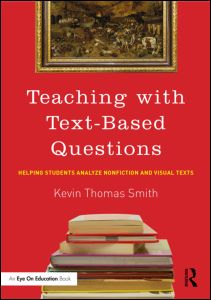How to Ask the Right Text-Based Questions
Teaching with Text-Based Questions: Helping Students Analyze Nonfiction and Visual Texts
By Kevin Thomas Smith
(Routledge, 2014 – Learn more)

If you are concerned about how to elevate the thinking in your classroom, how to infuse high quality nonfiction texts into your curriculum, or where to look for visual texts that will augment your language arts and/or social studies lessons, then look no further than Teaching with Text-Based Questions: Helping Students Analyze Nonfiction and Visual Texts.
Kevin Thomas Smith provides precisely what a teacher at any level of his or her career will need to jumpstart critical thinking, high quality conversations, and tight writing at any grade level. While Smith is a high school AP teacher with undeniably strong AP test results at the end of each year, his practical ideas easily translate to any student at any age. Additionally, his conversational tone throughout the book reminds his readers that they can be successful in raising the intellectual bar.

Chapter 1: Why Text-Based Questions
Chapter 2: The Different Types of Nonfiction Text
Chapter 3: Questions Students Should Be Asking About Texts
Chapter 4: Working with Multiple Texts
Chapter 5: Writing Good Responses to Text-Based Questions
Chapter 6: Evaluating Students’ Responses to Text-Based Questions
Richly resourced
While this skinny book with big ideas held my attention from beginning to end, it was chapters two and four that really set my highlighter in motion. The second chapter sparkled with links to various primary sources. Those links turned out to be a veritable “black hole” for me, as I found myself sucked into clicking over and over again as I discovered more and more engaging texts, charts and graphs, videos, and art pieces.
Reaching toward synthesis
Whereas the second chapter held a treasure trove of ideas, the fourth chapter was the apex for me. By scaffolding one visual piece or primary source slowly, Smith showed how he deftly was able to then integrate numerous pieces simultaneously. I loved how he masterfully showcased how to dovetail primary, secondary and visual art sources together. Synthesis is the level where we want all of our kids to get their hands the most dirty, after all.
Looking into visual text
Because I had spent a week at the Smithsonian American Art Museum being trained in Visual Thinking Strategies, Teaching with Text-Based Questions was a natural jumping off point for me. You see, Visual Thinking Strategies (VTS) seeks to do precisely what Kevin Thomas Smith is urging his readers to do: academically stretch the linguistic tools of students in a supportive, but challenging environment. VTS demands only three seemingly simple questions of its viewers:
- What’s going on in this picture?
- What do you see that makes you say that?
- What more can we find?
The work I did at the museum fits beautifully within Smith’s framework. In fact, Teaching with Text-Based Questions pushes my thinking along even further and encourages me to poke and prod my thinkers in ways I never imagined before. I am positive that my student’s thinking, speaking, reading, writing and listening skills will be honed like never before.
I am excited to go back to school next month and try out many of his ideas. The pages have been duly dog-eared and highlighted, and are merely patiently waiting for students to try out Smith’s many novel ideas.
Tess Alfonsin teaches fourth grade Language Arts at Saint Mary’s Hall in San Antonio, Texas. She was awarded campus Teacher of the Year and district Digital Star Teacher prior to moving to San Antonio. A self-professed “professional development junkie,” she has attended Lucy Calkins’ Reading Institute at Columbia Teachers College, and was selected to be an intern at Nancie Atwell’s Center for Teaching and Learning in Edgecomb, Maine. She credits the Clarice Smith National Teacher Institute at the Smithsonian American Art Museum for igniting a passion for visual learning, and seeks to engage the “Eye Generation” on a daily basis.
































